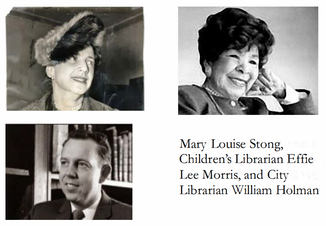 Tall, lanky, and with a drawl from out of town (Galveston, Texas), William Holman assumed the City Librarian's position in 1960. Impressed by the plethora of bookstores, Holman told a reporter, "San Francisco is a bookish, unique city… and it certainly doesn't deserve a third-rate library." He found the Main Library at civic center gloomy, dirty, smelly, technologically out of date. At its lowest point in 1959, only 1,500 books had been checked out, down from 12,000. In his first appearance before the Library Commission, Holman requested an emergency appropriation to fix an enormous backlog in cataloging and was told to wait for the city budget cycle a year later. His first encounter with the Board of Supervisor was not encouraging. His request for funds to hire nine additional Librarians was met by a scoffing Supervisor who yelled out, "that's welfare!" Holman ultimately won a small increase, insufficient to prevent the closure of all libraries on Sundays. Holman walked out of City Hall to find two citizen groups rumored to be organizing for library improvements: San Francisco for a Better Library and Friends of the Library that were in the process of merging. A meeting hosted at the home of Mortimer and Janet Fleishhacker brought the groups together, along with the Blyth-Zellerbach Committee, a business coalition shaping San Francisco's redevelopment efforts, to finalize the creation of a single organization with a list of founding sponsors, including Walter Haas, Nion Tucker, Ms. Dean Whitter, and the Zellerbach, Bransten, Follis, Schwabacher, and Gerbode families. In 1966, Margaret Mayer, who had joined the public library cause through volunteering at Friends' book sales, was hired as the first paid Executive Director. Friends first fundraising efforts furnished a new Rare Book Room, provided uniforms for security guards, and established a scholarship fund for librarians. Margaret Mayer and Board members Mary Louise Stong and Marjorie Stern were unified in the belief that the grassroots citizenry, not just the elite, must join the library movement. They committed themselves to publicize the library's dire budgetary situation and to build a grassroots membership organization for advocacy support. Ms. Stern later reflected, "What is really needed to make our library system an excellent one is solid citizen support. We tried hard to get out in the community for support for every section of the population. We believe that every citizen has a responsibility to the library." The desire to fight for a reformed public library went well beyond its new leader and his alliance with the newly formed Friends. The Librarians started a revolution from within, with Librarians making smart and significant changes with flat budgets. Among the leaders was Effie Lee Morris (more info), a nationally recognized children's librarian from the New York Public Library who served as the SFPL's first-ever Children's Services Coordinator. With predominantly female leadership, the adult services department was created under Harriet Collopy, technical services and cataloging under Vivian Goodwin, branches under Mary Moses, and the Main under Avis Stopple. Collections were reorganized more strategically by interest, 100,000s of books previously held behind reference desks were shelved for accessible public browsing, and the Business and Science Department opened. Inadequate budgets still limited progress, but the coalition of Friends and the SFPL began to make headway with a steady and coordinated strategy. Librarian Holman figured out that he was more likely to obtain budget allocations from city hall when he sent a series of small requests instead of large annual requests. When he made a budget request, he alerted Friends, who mobilized its members to visit city hall to publicly and loudly back the requests. By 1965, this strategy paid off when the book-buying budget was raised from $381,000 to $500,000. By 1967, the overall Library budget was double was it had been in 1961. Historical data cited from A Free Library in the City, by Peter Booth Wiley. Photos credited to the SFPL History Center.
Coming in March, Chapter Three: SFPL in 1960s. Read Chapter 1 here.
1 Comment
|
AuthorWrite something about yourself. No need to be fancy, just an overview. Archives
May 2024
Categories |
ADMINISTRATIVE OFFICES &
|
Get INvolvedContact UsTax ID Number: 94-6085452 ©2021 Friends of the San Francisco Public Library
|
SUBSCRIBE TODAY FOR UPDATES!
|
